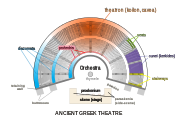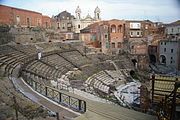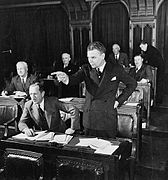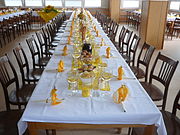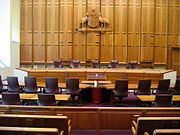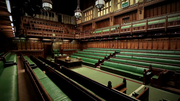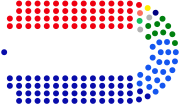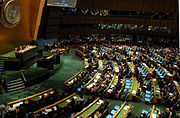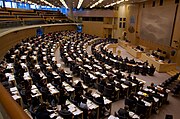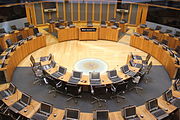Debate chamber
This article needs additional citations for verification. (July 2020) |
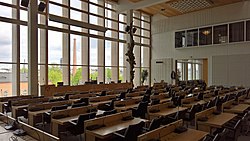
A debate chamber is a room for people to discuss and
Debating
Debating can happen almost anywhere. Whether informal or structured as a discourse between select individuals or small groups with an audience, debates often occur with an audience. The debate does not directly involve the audience as they are not participants - they may even be remote, watching on television. The debating chamber is where the debate participants engage: the stage, panel or council table, or the presentation station. The audience is separate, even if the lines between participants and audience are not always distinct. The positioning of the debating participants is normally oppositional (to each other) or side-by-side in a fan-shape with the focus being the moderator's table (or audience). If there is an audience present, the moderator is normally positioned to the side or with back to the audience (or cameras), or sometimes positioned between the debating participants, especially if there are more than two participants. In the case when the moderator is not between the participants, as a rule, there are more than 2 and rarely more than approximately 15 participants. More than this typically involves a formally debating body or organization, such as a legislative body, which usually meets in a designated place or chamber, often purpose-built for this function.
Psychology and geometry
The configuration of seating affects interpersonal communication on conscious and subconscious levels. For example, disagreements over the shape of a negotiation table delayed the Vietnam War peace talks for almost a year.[2]
Interpersonal communication involves both visual and aural senses. Faces are important sources of both visual and aural information (e.g., facial expressions and voices); and a person's means of receiving such information (namely the eyes and ears) are most effective when able to face their focus of interest directly. Thus, communication is best facilitated through
The geometry of seating position can further support or determine a sense of opposition/confrontation, hierarchy/dominance, or collaboration/equality. Factors such as angle/rotation, proximity/distance, median/termini, and height/incline must all be considered. The more directly two parties are positioned across from one another, the more likely their relationship will be one of opposition to each other; the less direct, or more "side-by-side" these positions are, the less likely such an opposing relationship becomes, but also the less effective it will be at fostering collaboration.
These effects can be observed in debate chambers, meeting rooms, and at dining or restaurant tables. For instance, with a long rectangular table, those seated at the "head" or "end" of the table are in a position of dominance; they can see everybody, and normally everybody can see them, but the others are restricted to seeing only those across from them. Circular, square, or elliptical tables facilitate more equal status between those seated, as well as less obstructed lines of sight. A circular gathering with three participants provides the only non-oppositional configuration of more than two persons that allows equal line of sight (all 120 degrees apart).
The smaller the group and setting, the greater the equity of participants and sight lines. Conversely, the more participants that are present, the greater is the disparity of sight lines between those sitting immediately adjacent and those more directly across, whose position in turn becomes more oppositional.[3] Winston Churchill recognized this when he insisted the British House of Commons be rebuilt (after wartime bombing) in a similar size and configuration as the prior chamber, to maintain the intimate and adversarial style of debate which he believed was responsible for creating the British form of government.[4]
History
Whether outdoors or in an enclosed space or chamber, such as a cave, it is likely that the earliest designated places for group discourse or debate occurred around a fire, for light, heat, or protection from predators. Throughout recorded history there have been a variety of places and spaces designated for similar purposes. An early gathering for assembly purposes was the
The first official debating model that emerged (centuries later) after the fall of the Roman Empire was the
In the 14th century, the king of France established the
In the late 18th century the
Names
The names given to debating places or spaces may refer to an activity, such as assembly or debating; it may refer to the persons performing that activity, such as noblemen (Oireachtas in Ireland), lords, or estates; or it may refer to both, such as Senate (derived from the Latin for elder, and assembly). Some examples of the more common names for debating spaces:
- Assembly, also Dáil in Irish, as in National Assembly.
- Chamber or House, as in House of Representatives or Chamber of Deputies.
- Council, as in Magnum Concilium, or Federal Council.
- ).
- Duma: Russian, meaning "consider".
- Parliament: derived from Anglo-Norman parler, meaning speak.
- Rada: Derived from Old East Slavic Рада, meaning council (ex. Verkhovna Rada in Ukraine, meaning Supreme Council).
- Sejm: Proto-Lechitic, meaning "gathering" or "meeting".
- senex, meaning "old man").
- .
Seating configuration
There are several common configurations of seating used in debate chambers: auditorium, rectangular, fan-shaped, circular, and hybrids. The shapes of the room vary and do not necessarily reflect or match the seat configurations. The architectural design of the chamber can shape the style of debating: a semicircular design may promote discussion for the purpose of reaching a consensus, while an arrangement with two opposing sides may promote adversarial debating.[6]
Auditorium
The auditorium form of seating (and chamber) is a large audience facing a stage, often with a proscenium. The model is similar to direct instruction whereby the communication is unidirectional without active interaction or debate. Response is limited to applause or speakers coming onto the stage, from the audience or backstage, to provide a subsequent presentation to the audience. Given the scale and format, there is little opportunity for any direct discourse.
Examples and images:
-
China's Great Hall of the People
Council and court
The
Examples and images:
Rectangular
The rectangular (
Common folklore speaks of the aisle between the government and the opposition sides as being "two sword lengths", or "two sword lengths plus an inch", apart, although there is no record of this being a criterion.[7]
Examples and images: House of Commons of Canada, House of Commons of the United Kingdom, Cortes of Castilla–La Mancha
Hybrid
A hybrid of the bifurcated and semi-circular seating configurations combines a central aisle with a curved end at one end facing the focal point (e.g. Speaker's chair) at the other. Another hybrid form is one that is rectangular, but not bi-furcated; the overall arrangement is rectangular, as is each of the three seat groupings. For example, in both the lower house of the
Examples and images:
Fan-shaped
The
Its form allows for presentation by a single person, or small group, to speak or present to all members of the chamber on a face-to-face basis from a podium (or similar element) at the focal point of the room. The primary hierarchy of position is largely distance from the podium, and is not in a position of support or opposition. This position gives pride of place to the podium, is not inherently partisan, and if each member of the group is given the chance to address the group, everyone has a (theoretically) equal position.
Examples and images:
-
Fan-shaped: National Assembly of France seating plan. The president of the assembly's dias is at the bottom (not shown)
-
US House of Representatives with the President addressing a joint session of Congress
-
United Nations General Assembly Hall
-
Finnish Parliamentdebating chamber
-
Debating chamber of theChamber of Deputies of Brazil
-
Scottish Parliament debating chamber
-
German Bundestagdebating chamber
-
Debating chamber of theSwedish Riksdag
Circular
Circular seating configurations for places of discourse have been envisioned as early as the 12th Century story of the Knights of the Round Table. As with many later versions, this was intended to be a collaborative forum. In the late 1940s, facilities for the United Nations Security Council, a body formed during and immediately after the world's greatest conflict, were designed to support collaboration and avoid confrontation.[10][11]
Since the early 1990s, several debating chambers have been constructed that support, or were designed to support, consensus-style or collaboration-style discourse and government. These include legislative assembly facilities for indigenous and non-indigenous peoples in Northern Canada, Great Britain, and Polynesia. Most are for bodies that do not involve formal political parties.[12][13]
Examples and images:
-
Debating Chamber of the Senedd of Wales
-
Chamber of City Hall, London (Southwark)
-
Society of Friends meeting house
-
Nisga'a Lisims Government Chamber
-
Chamber of the Northwest Territories Legislative Assembly
Virtual
The introduction of regular live television broadcasts of legislative chambers, which began with the Canadian House of Commons in 1977,[14][15] has influenced debate and extended the audience well beyond the physical location of the debate chamber. More recently this has developed into direct two-way communication in small and large meeting rooms (virtual events), and even through personal hand-held devices into nearly every corner of the world. This has both changed the nature of the physical nature of the debating environment into a digital and virtual one, and in a non-literal sense into a series of ever-changing and highly varied configuration and collection of spaces determined by where each debate participant happens to be located. This may also have the added effect of drawing others into the debate, whether as passive observers or active participants, unwittingly, uninvited, or by active invitation of a single participant. For those meetings or debates who remain grounded in a structured location, such as a conference room or legislative chamber who connect to one or several remote participants via video-conferencing, the configuration of the room may be re-focused onto the video screen and away from those in the room.
Notes and references
- ^ Guide to the debating chamber. New Zealand Parliament. Retrieved 2016-04-11
- ^ Contract Pricing Finance Guide, Chapter 5, Office of the Under Secretary of Defense for Acquisition, Technology and Logistics Archived 2018-07-29 at the Wayback Machine. Retrieved 2016-04-11
- ISBN 0273772236. Retrieved 2016-04-11
- ^ Churchill and the Commons Chamber - UK Parliament webpage. Retrieved 2016-04-11
- ^ Encyclopædia Britannica, National Assembly - Historical French parliament. Retrieved 2016-04-14
- ^ "Could we fix democracy if we moved the seats around?". Tomorrow. 2012-07-29. Retrieved 2017-07-03.
- ^ UK House of Commons chamber, UK Parliament. Retrieved 2016-04-11
- ^ Manow, P.23
- ^ Capitol Hill Neoclassical Architecture, Architect of the Capitol. Retrieved 2016-04-14
- ^ UN Security Council, Relationships and Collaboration. Retrieved 2016-04-14
- ^ Ingeborg Glambek: The Council Chambers in the UN Building in New York, Scandinavian Journal of Design History, vol. 15, 2005, pp. 8-39. Retrieved 2016-04-14
- ^ What is Consensus Government? - Government of the Northwest Territories. Retrieved 2016-04-11
- ^ Nisga'a Lisims Government - Building Tour. Retrieved 2016-04-11
- ^ History of CPAC, Canadian Public Affairs Channel. Retrieved 2016-04-14
- ^ Parliament of Canada, Broadcasting Services. Retrieved 2016-04-12


